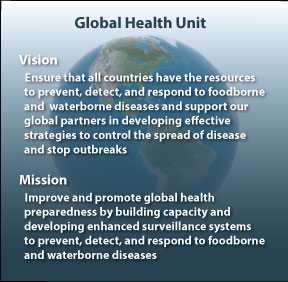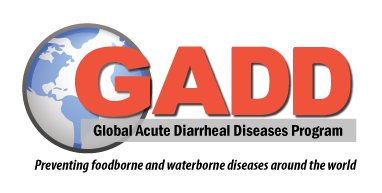Global Health Unit

Countries with effective laboratory and public health resources are better-equipped to prevent, detect and respond to the threat of diarrheal diseases. The Global Health Unit (GHU) works with ministries of health in various countries to develop those resources internationally.
The GHU team trains international partners to train their scientists and public health professionals. Through GHU projects and the team’s work with global partners, eight countries in four world regions have strengthened their ability to respond to enteric diseases. GHU’s work has touched over 3 billion people.
- The Global Health Unit, an activity of the Division of Foodborne, Waterborne, and Environmental Diseases, coordinates global health activities worldwide. The team works with many global health partners to prevent, detect, and respond to diarrheal diseases caused by contaminated food and water. Its partners include:
- Other CDC staff, including the Center for Global Health’s Field Epidemiology Training Program and Global Disease Detection Program
- Global Health Security Agenda
- Member country offices
Recent GHU projects include:
- Global Acute Diarrheal Diseases (GADD) Program which increased the number of responders and strengthened their outbreak detection and surveillance systems
- Three Global Health Security Agenda projects, including a toolkit in rapid development, to guide partners in building sustainable infrastructures
Projects Funded by the Global Health Security Agenda
The Global Health Security Agenda (GHSA) is a growing partnership of nearly 50 nations, international organizations, and non-governmental stakeholders working to create a world secure from infectious disease threats and make global health security a national and global priority. (Learn more about GHSA and its CDC partnership.)
The Global Health Unit launched several projects supported by GHSA funding in 2015.
- The acceleration project is a toolkit for detecting and tracking foodborne and waterborne outbreaks.
-
Flagship projects for Uganda and Cameroon are the first step towards building sustainable capacity in these countries. DFWED and other CDC partners are collaborating on these projects.
- In Uganda, this is focused on surveillance for causes of acute febrile illness.
- In Cameroon, efforts are focused on how to prevent, detect, and respond to cholera through integrated systems for public health emergency management.
- GHU assisted CDC partners, CDC-Indonesia and the Indonesian Field Epidemiology Training Program (FETP) in developing laboratory training on cholera for FETP students.
Global Acute Diarrheal Diseases Program
Every year, 550 million people get sick and 230,000 die from diarrheal diseases. Through the Global Acute Diarrheal Diseases (GADD) program, the Global Health Unit’s partners have increased the number of responders and strengthened outbreak detection and surveillance systems.

Our work with two countries, India and Georgia, illustrates successful partnerships in fighting deadly diarrheal diseases.
- GHU and India, a GADD program participant since 2010:
- Organized two strategic planning meetings and five training courses on outbreak response and microbiological principles
- Coordinated two ongoing, pilot projects in the states of Tamil Nadu and Gujarat with possible expansion to additional sites in 2016
- GHU and Georgia, a GADD program participant since 2011:
- Coordinated three temporary assignments to Georgia, to develop epidemiology and laboratory enteric diseases capacity
- Each visit included support from several CDC partners and built on the activities from previous trips: consulting, hands-on-epidemiology and laboratory training at the district and national level, and physician outreach
- Coordinated three temporary assignments to Georgia, to develop epidemiology and laboratory enteric diseases capacity
The GADD Program’s three-step approach strengthens countries’ abilities to reduce diarrheal diseases globally:
- Consultation: Consult with partner countries and develop training plan for epidemiology and laboratory fellows and select ministry of health staff.
- Capacity Building: Work with foreign ministries and U.S. state health departments to build a sustainable platform for outbreak investigations at local, district, and national levels of the health system in partner countries.
- Applied Training and Implementation: Provide technical assistance for enhanced surveillance and investigation of enteric disease outbreaks through mentorship and intervention evaluations.
Global Impact of Diarrheal Diseases

Diarrheal Diseases from Contaminated Food
- Almost 1 in 10 people worldwide get sick every year from eating contaminated food; 420,000 die as a result.
- 550 million people get sick and 230,000 die from diarrheal diseases every year. This is more than half of all foodborne diseases worldwide.
- Children younger than 5 are at high risk from foodborne disease; 220 million get sick and 96,000 die every year.
Source: http://www.who.int/mediacentre/news/releases/2015/foodborne-disease-estimates/en/
Diarrheal Diseases from Contaminated Water
- Globally, at least 1.8 billion people use a drinking-water source contaminated with feces.
- Unsafe drinking-water is estimated to cause 502,000 diarrheal deaths each year.
- An estimated 842,000 people die each year from diarrhea as a result of unsafe drinking water and inadequate sanitation and hand hygiene.
- Page last reviewed: May 20, 2016
- Page last updated: May 20, 2016
- Content source:


 ShareCompartir
ShareCompartir